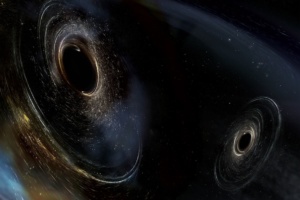2017 Nobel Prize in Physics Awarded for Gravity Wave Detection
A long time ago in a galaxy far, far away…
This now famous opening scroll of Star Wars is a fitting and appropriate way to open this story as it describes -perfectly- the environment, origin and progenitor of these waves.
Yesterday, 3 October, in what the prestigious Royal Swedish Academy described simply as “a discovery that shook the world”, three Americans, the legendary Kip Thorne of the California Institute of Technology (CalTech), Barry Barish, also of CalTech, and Rainer Weiss, professor of Mathematics at the Massachusetts Institute of Technology (MIT) were awarded this year’s Nobel Prize in Physics “for decisive contributions to the LIGO detector and the observation of gravitational waves”, waves famously predicted by Albert Einstein’s General Theory of Relativity over a century ago.
This theory predicted that matter and energy would warp the geometry of space-time much in the same way a bowling ball would depress a stretched rubber sheet and that this effect was the true essence of gravity, that any object would follow the curvature of space with the magnitude of that curvature dependent on the mass of the object(s). A logical outcome of this theory allows for this “space-time fabric” to be warped and distorted to the point of rupture for objects of a certain mass. The objects that would cause this “ripping” of space time became known as Black Holes as their tremendous gravity prevented the transmission of any information beyond a certain “Event Horizon”, a distance from the singularity (point mass) within which light could not escape. These gravity waves would stretch and compress space in perpendicular directions as they propagate from their source along the space-time fabric, much the same way that sound waves compress air.
 Last February, using the LIGO (Laser Interferometer Gravitational-Wave Observatory) facilities in Hanford, Washington and Livingston, Louisiana, an international collaboration of physicists and astronomers announced that they had recorded gravitational waves a year earlier on 14 September 2015, emanating from the collision of a pair of massive black holes a billion light years away, a long time ago in a galaxy far, far away…
Last February, using the LIGO (Laser Interferometer Gravitational-Wave Observatory) facilities in Hanford, Washington and Livingston, Louisiana, an international collaboration of physicists and astronomers announced that they had recorded gravitational waves a year earlier on 14 September 2015, emanating from the collision of a pair of massive black holes a billion light years away, a long time ago in a galaxy far, far away…
In order to detect these ripples in space-time, the LIGO detectors, composed of perpendicularly aligned finely tuned lasers ( laser interferometers) are sensitive to “out of phase” conditions of the laser beams -conditions that signify the possible detection of gravity waves- have to be extraordinarily sensitive, so much so, that a mosquito landing on a roadway a kilometer distant would be detected. Described differently, the laser interferometers are so finely tuned that a change in the lengths of the perpendicular arms of one part in ten to the 18th meters (a thousandth the diameter of an atomic nucleus) can be detected.

